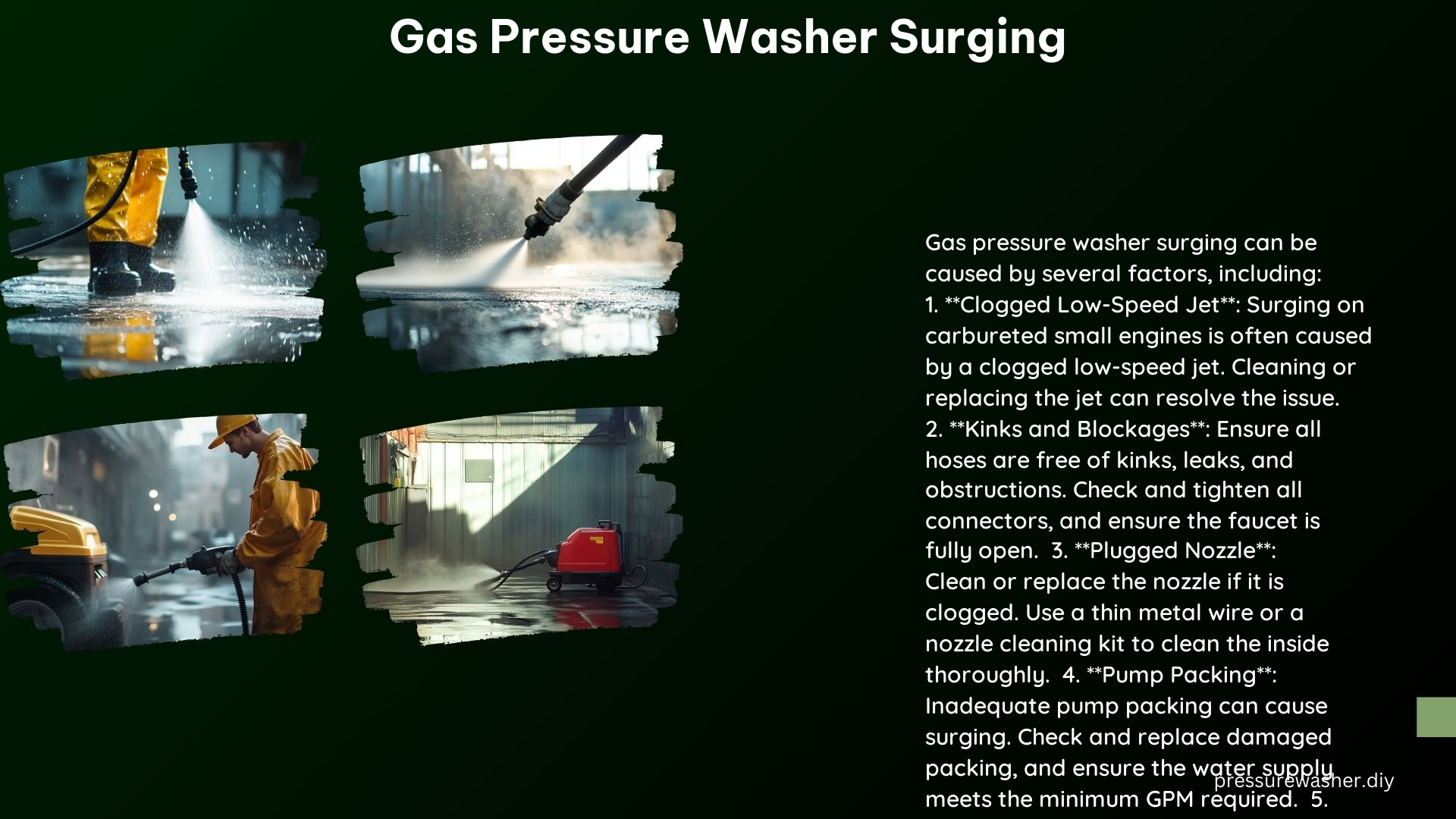Gas pressure washer surging is a common issue that can significantly impact the cleaning performance and longevity of your gas-powered pressure washer. This comprehensive guide will delve into the common causes, effective diagnosis, and proven prevention methods to help you maintain a consistent and reliable pressure output from your gas pressure washer.
Common Causes of Surging in a Gas Pressure Washer
-
Kinks and Blockages in the Hose or Pump: Ensure all connected hoses are free of kinks, leaks, and obstructions. Check that all hoses fit and are correctly connected. Kinks or blockages in the hose or pump can restrict water flow, leading to pressure fluctuations and surging.
-
Plugged Nozzle: A clogged spray nozzle can cause back-pressure, resulting in surging. Use a thin metal wire or a nozzle cleaning kit to thoroughly clean the inside of the nozzle, removing any debris or mineral buildup.
-
Pump Packing: Inadequate pump packing can cause surging. Check the water supply and ensure the pump is receiving the minimum required gallons per minute (GPM) to operate efficiently. The recommended GPM for a typical gas pressure washer is between 2.5 to 4 GPM.
-
Air in the Pump: Trapped air in the pump can cause surging. Check the pump and hose for any air pockets or leaks, and remove any trapped air to ensure a consistent water flow.
-
Fuel Issues: Clogged carburetors, particularly low-speed jets, can cause surging. Clean or replace the carburetor if necessary, ensuring the fuel mixture is properly adjusted.
-
Unloader Valve Issues: The unloader valve may be restricted or clogged, causing surging. Clean or replace the valve if necessary, following the manufacturer’s instructions.
-
Water Supply Issues: Ensure a consistent and sufficient water supply to the pump. Fluctuations in water pressure or flow rate can lead to surging.
Diagnosing and Fixing a Surging Issue

-
Check the Hose and Pump: Inspect all hoses for kinks, leaks, or blockages, and ensure all connections are secure.
-
Inspect the Nozzle: Clean or replace the nozzle if it is clogged, using a nozzle cleaning kit or a thin metal wire.
-
Check Pump Packing and Water Supply: Ensure the pump packing is adequate and the water supply meets the minimum GPM required by the pressure washer.
-
Check for Air in the Pump: Remove any trapped air from the pump and hose by running the pressure washer with the gun open until the water flow is consistent.
-
Inspect the Carburetor: Clean or replace the carburetor if it is clogged, following the manufacturer’s instructions.
-
Check the Unloader Valve: Clean or replace the unloader valve if it is restricted or clogged, as per the manufacturer’s recommendations.
Preventing Surging in a Gas Pressure Washer
-
Regular Maintenance: Flush the hose and pump after each use to remove residual dirt and debris, which can contribute to surging.
-
Use a Water Filter: Install a water filter to prevent dirt and debris from entering the pump and nozzle, which can cause clogging and surging.
-
Keep the Pressure Washer Clean: Regularly clean the exterior of the pressure washer and check its components for signs of wear and tear.
-
Store the Pressure Washer Properly: Store the pressure washer in a dry, protected space to prevent moisture damage, which can lead to issues like surging.
Technical Specifications
-
Pressure Output: Ensure the pressure washer is operating within its specified pressure range. For example, the Ryobi RY80940B has a pressure output of 3,100 PSI.
-
Water Flow Rate: Check the water flow rate to ensure it meets the minimum GPM required by the pump. A typical gas pressure washer requires a water flow rate between 2.5 to 4 GPM.
-
Engine Performance: Monitor the engine’s RPM and performance to ensure it is operating within its specified range, as any issues with the engine can contribute to surging.
By understanding the common causes, effectively diagnosing the issue, and implementing preventive measures, you can maintain a consistent and reliable performance from your gas pressure washer, ensuring a smooth and efficient cleaning experience.
